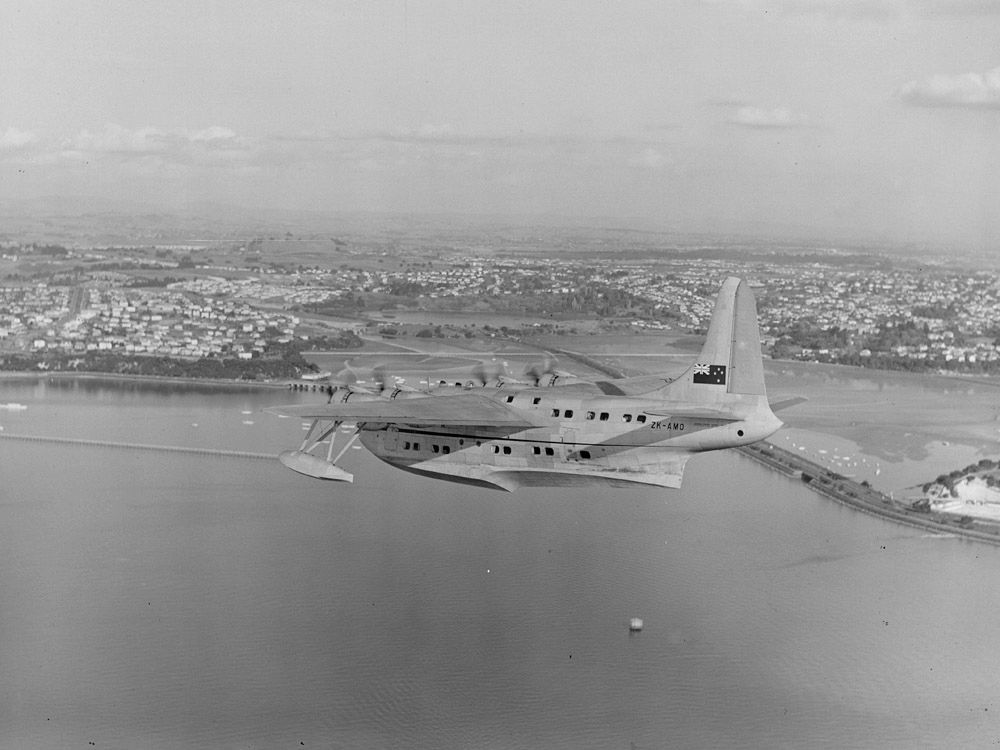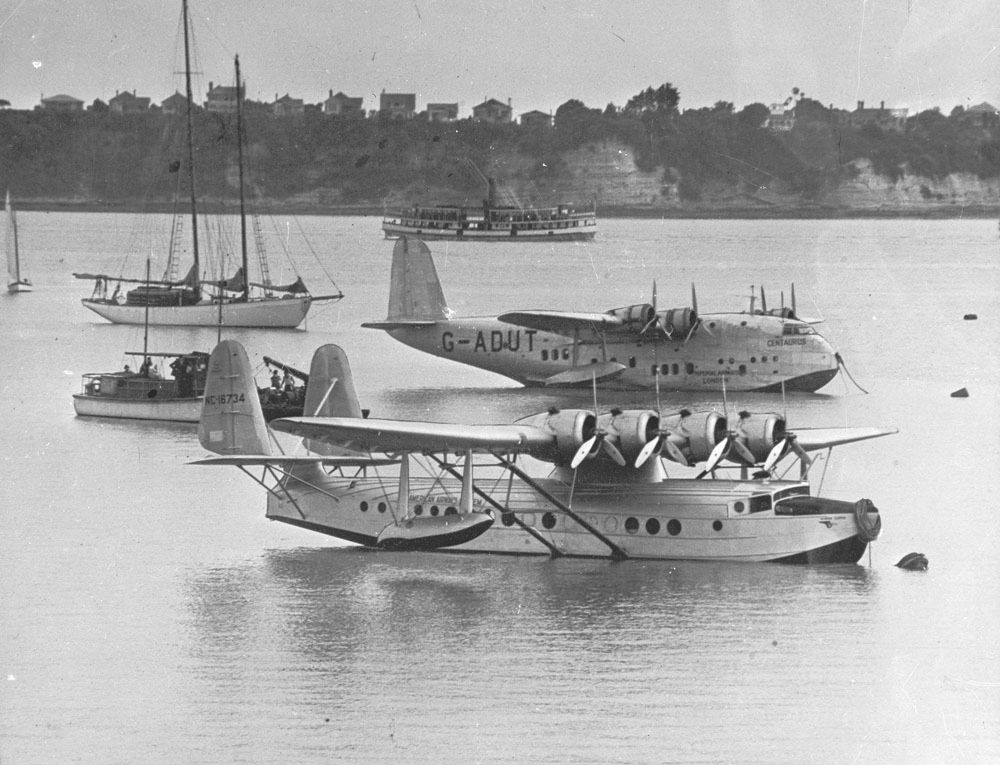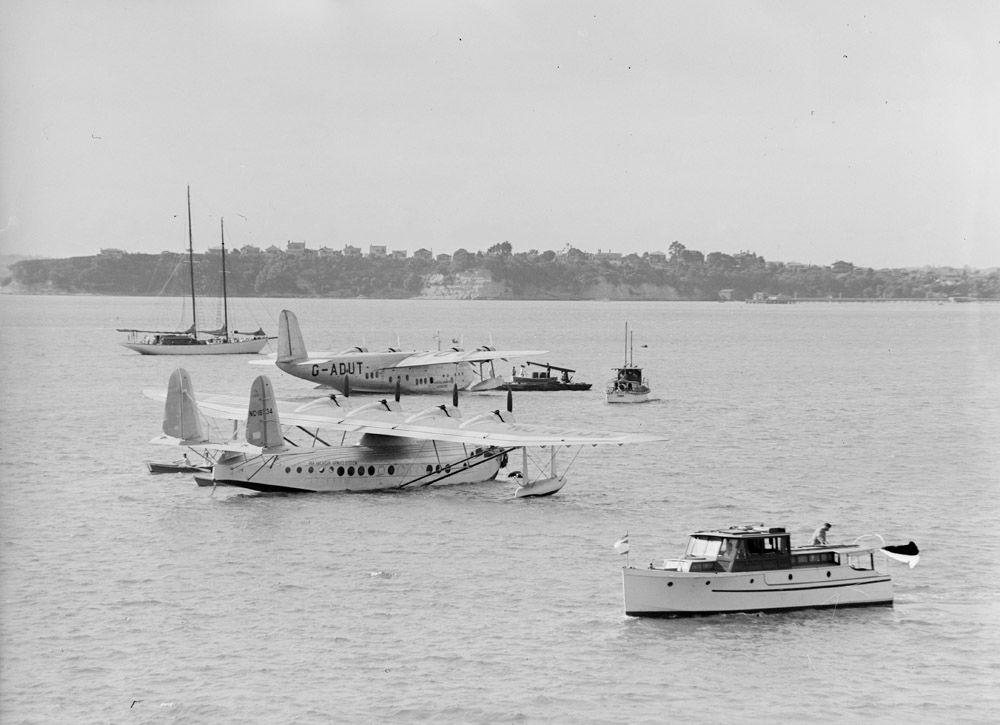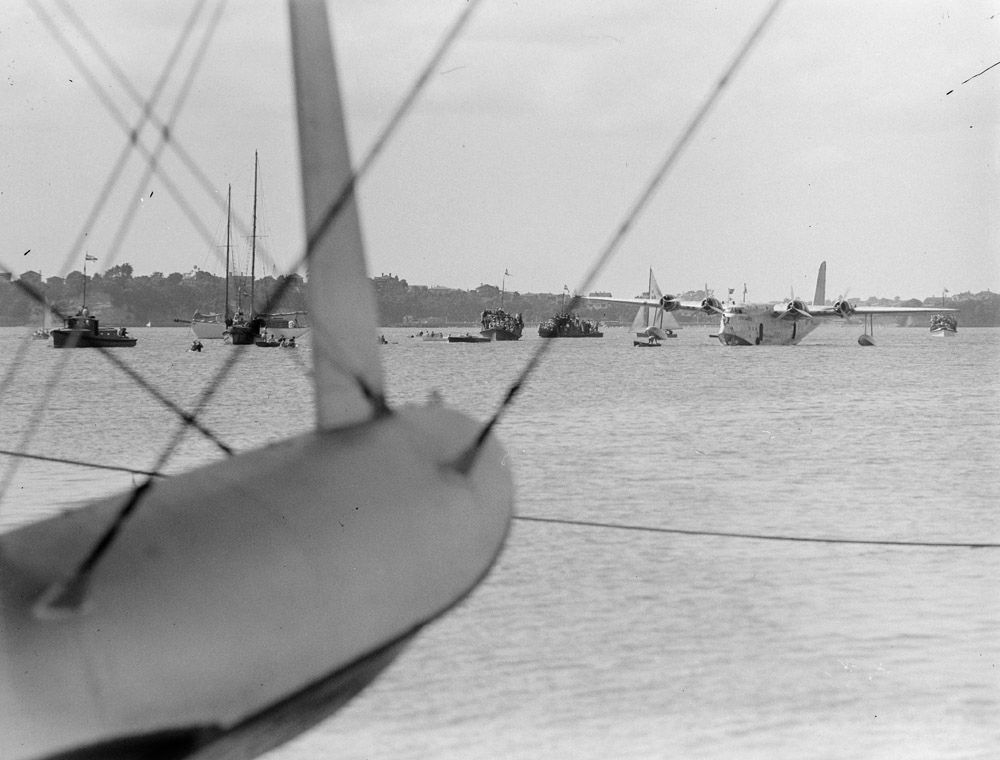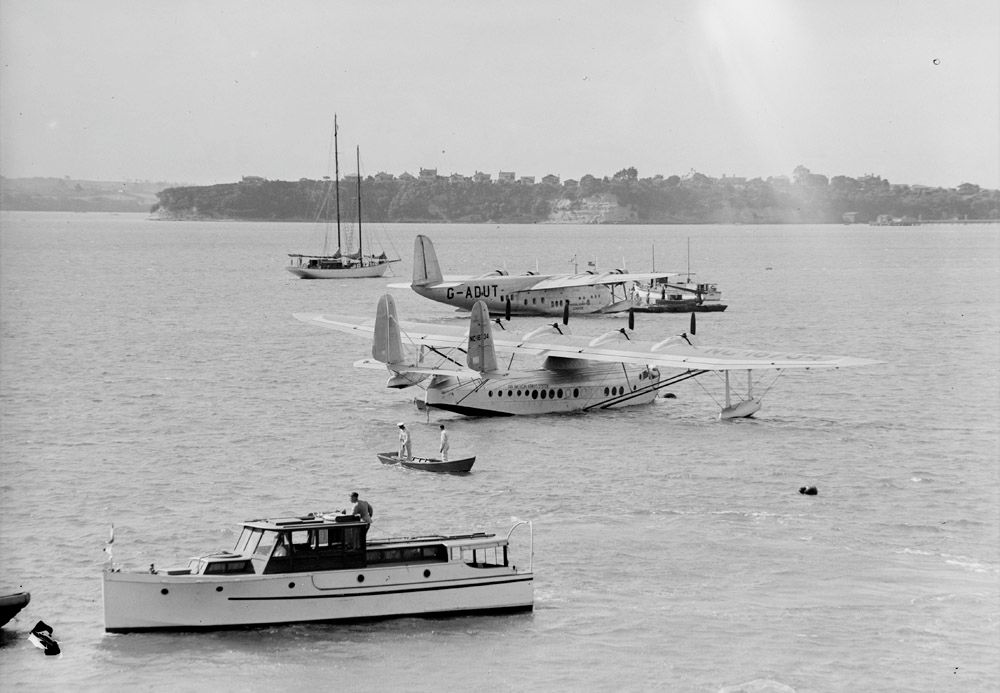Flying boats
Join Date: Nov 2005
Location: london
Posts: 379
Likes: 0
Received 0 Likes
on
0 Posts
#17/19: Catalina endurance. B.Pattison&G.Goodall, Qantas Indian O. Service 1943-46, AHS/Oz,1979. 5 a/c, 217 crossings Swan R - Koggala Lake vv. Payload upto 1,100 lb., average duration 27 hr., min. 22.46, max. 29.10hr. Overload t/o up to 4 tons - "tight" off Koggala. QEA engine opnl.plan had notional max endurance of 36 hr.
Farnborough Show Shacks had no payload.
Farnborough Show Shacks had no payload.
A relatively light airframe (for a flying boat), ie no flaps, fabric covered trailing edges. Engines are similar to the DC-3 family, again not that heavy or powerful for the size of airplane but that won’t be a problem with miles of (wet) runway. The lower powered engines means a relatively low fuel consumption. Combine all this with a big wing to store loads of fuel and away you go. I’ll happily look up some numbers but that will have to wait till I get home to my books.
Catalina (PBY-5A):
- Empty weight 20,910 lbs / max TO weight 35,420 lbs
- Fuel capacity 1495 US gallons with self sealing tanks, 1750 US gallons without self sealing liner.
- Cruise speed 125 mph
- Range 2520 mi
DC-3A:
- Empty weight 16,865 lbs / max TO weight 25,199 lbs
- Fuel capacity 822 US gallons
- Cruise speed 207 mph
- Range 1500 mi
You can see from these figures that with the same engines, the PBY is somewhat heavier (but this is for the amphibious version, the PBY-4 weighed in at 24,813 lbs gross and the earlier ones were less than that) but even with the self-sealing tanks has almost double the fuel capacity. If you take an earlier non-amphibious PBY you've got 10,000 lbs less weight to carry but if you use the non-self-sealing tanks you've got 1750 US gallons of fuel on board. That will go a long way if you use it conservatively. The PBY-5A range and cruise speed gives you an endurance of over 20 hours, but I don't know if that includes reserves or leads to empty tanks. Roscoe Creed's 'PBY The Catalina Flying Boat' quotes a patrol range of 2860 miles for a non-amphibious PBY-5 and I assume that this includes reserves and is based on a normal cruising power setting, not a long range power setting.
Catalina (PBY-5A):
- Empty weight 20,910 lbs / max TO weight 35,420 lbs
- Fuel capacity 1495 US gallons with self sealing tanks, 1750 US gallons without self sealing liner.
- Cruise speed 125 mph
- Range 2520 mi
DC-3A:
- Empty weight 16,865 lbs / max TO weight 25,199 lbs
- Fuel capacity 822 US gallons
- Cruise speed 207 mph
- Range 1500 mi
You can see from these figures that with the same engines, the PBY is somewhat heavier (but this is for the amphibious version, the PBY-4 weighed in at 24,813 lbs gross and the earlier ones were less than that) but even with the self-sealing tanks has almost double the fuel capacity. If you take an earlier non-amphibious PBY you've got 10,000 lbs less weight to carry but if you use the non-self-sealing tanks you've got 1750 US gallons of fuel on board. That will go a long way if you use it conservatively. The PBY-5A range and cruise speed gives you an endurance of over 20 hours, but I don't know if that includes reserves or leads to empty tanks. Roscoe Creed's 'PBY The Catalina Flying Boat' quotes a patrol range of 2860 miles for a non-amphibious PBY-5 and I assume that this includes reserves and is based on a normal cruising power setting, not a long range power setting.
Last edited by Jhieminga; 30th Oct 2017 at 20:34. Reason: Added numbers
I did ground handling on a Norwegian Catalina at RAF Ballykelly (1960?),that's the only flying boat I have seen !!I see the Catalina at Cosford museum is painted in Norwegian air force colours now.
Join Date: Oct 2016
Location: Christchurch
Posts: 74
Likes: 0
Received 0 Likes
on
0 Posts
The Catalina could be fitted with ferry tanks in the cabin, four long metal cylinders mounted in a wooden cradle (combined capacity, of "about 325 Imperial gallons"), in a position directly below the centre of gravity, and as merely ferry tanks, had no self sealing protection. It was these tanks which allowed the very long endurance of over 24 hours, as the wing tanks could never hold enough for such endurance. The fuselage ferry tanks required that they be opened in flight, then a suction transfer pipe powered by an electric fuel pump was plunged through the opening and the pump started on its task, forcing the fuel "upstairs" into the wing tanks. These ferry tanks were also used by RAF Cats during the search for the Bismarck in May 1941, despite their lack of protection, such was the importance of the operation. Later Catalinas also had provision for underwing drop tanks, but these were very rarely used, and normally only for ferrying - however these would have been a lot safer than the earlier cabin tanks. To give a more detailed account of the operation of the cabin tanks, the following is extracted from the Pilot's and Flight Engineer's Notes for the Catalina I, IB, II, IV, IVA and IVB flying boats (AP-2036A, B, D, E & F -PN), Paragraph 1, Fuel and Oil Systems. "An electrically driven pump is mounted on top of the upper tank (except on Mk. IV, see para. 93) to which current is supplied via a flexible lead from a socket marked RECEPT AFT on the starboard aft face of bulkhead No. 4. The pump is fitted with a flexible suction hose terminating in a length of rigid pipe which can be inserted into any one of the (ferry fuel) tanks after unscrewing the blanking plug from the filler cap. The flexible delivery is connected by a union on the port side to an external pipe and fuel is pumped through this into the port wing tank via the drain valve."
The standard wing tanks of Catalinas held about 875 US gallons each side (725 Imperial) to give a total of 1,750 US (1,450 Imperial). In Part II of the Notes (para. 51 (ii), Management of Fuel System - Instructions for the use of auxiliary tanks) it is stated under sub-para. 51:ii(b) "During transfer the wing tank gauge should be watched, and when the required amount of fuel has been transferred the pump should be switched off concurrently with the shutting off of the drain valve. The port wing tank contents can then be equalised with the starboard tank contents by turning both main fuel cocks (43) to BOTH ON. After the pumping operations are finished, the suction pipe stop cock should be closed and care should be taken that any fuel remaining in the suction pipe is not splashed about indiscriminately. Tank caps should be replaced immediately." This last instruction is then followed by a further note of caution, stating: "It should also be remembered that a dangerous concentration of vapour may remain in the aircraft for some considerable time, therefore naked lights should be strictly avoided."
Thus operating these aircraft far out over the Atlantic in May 1941 looking for Germany's most formidable battleship (which was equipped with the most modern A/A radar-controlled armament) took a special kind of nervous courage.
David D
The standard wing tanks of Catalinas held about 875 US gallons each side (725 Imperial) to give a total of 1,750 US (1,450 Imperial). In Part II of the Notes (para. 51 (ii), Management of Fuel System - Instructions for the use of auxiliary tanks) it is stated under sub-para. 51:ii(b) "During transfer the wing tank gauge should be watched, and when the required amount of fuel has been transferred the pump should be switched off concurrently with the shutting off of the drain valve. The port wing tank contents can then be equalised with the starboard tank contents by turning both main fuel cocks (43) to BOTH ON. After the pumping operations are finished, the suction pipe stop cock should be closed and care should be taken that any fuel remaining in the suction pipe is not splashed about indiscriminately. Tank caps should be replaced immediately." This last instruction is then followed by a further note of caution, stating: "It should also be remembered that a dangerous concentration of vapour may remain in the aircraft for some considerable time, therefore naked lights should be strictly avoided."
Thus operating these aircraft far out over the Atlantic in May 1941 looking for Germany's most formidable battleship (which was equipped with the most modern A/A radar-controlled armament) took a special kind of nervous courage.
David D
Gnome de PPRuNe
Join Date: Jan 2002
Location: Too close to Croydon for comfort
Age: 60
Posts: 12,620
Received 294 Likes
on
162 Posts
Oldpax, the Cosford Cat's still in its Danish AF scheme isn't it?
Treadi - yes, saw it a few weeks ago. Interesting for me as DiL is Danish and she and my son live in Copenhagen
Jheiminga - many thanks - fascinating
Kiwi - great photos, but what is the three engine bird with all the wires.
Jheiminga - many thanks - fascinating
Kiwi - great photos, but what is the three engine bird with all the wires.


QuePee
25th Wedding Anniversary coming up. I wonder what it would take to convince Mrs T to take the Cat?

Join Date: Jun 2008
Location: Doonfoot, Ayr
Age: 70
Posts: 42
Likes: 0
Received 0 Likes
on
0 Posts
I seem to remember Sunderlands off Troon/Barassie shore on the west coast of Scotland when I was a boy in the early 60's - I don't think I was dreaming! Is that possible?
The Loch Lomond Cessna T206H did a touch-and-go during this year's airshow at Ayr. First I've seen. Also had the Catalina displaying again. Very good it was too.
The Loch Lomond Cessna T206H did a touch-and-go during this year's airshow at Ayr. First I've seen. Also had the Catalina displaying again. Very good it was too.
Gnome de PPRuNe
Join Date: Jan 2002
Location: Too close to Croydon for comfort
Age: 60
Posts: 12,620
Received 294 Likes
on
162 Posts
French Navy used Sunderlands up until December 1960.
However, given the proximity to Prestwick, possibly US Navy or USAF flying boats - Grumman Albatrosses maybe?
However, given the proximity to Prestwick, possibly US Navy or USAF flying boats - Grumman Albatrosses maybe?
My first flight was in a Sunderland from Pembroke Dock in 1953. We were on a two week CCF summer camp and flew almost every day, sometimes for a very long time!
The memories have faded, but noise and seawater dringing off the props during take-off, which seemed to take forever, stick in my mind. The Sunderland was very draughty, particularly near the front turret. Sitting in the rear turret I felt very isolated as we droned over the whitecaps a thousand feet below. Preparing the aircraft for take-off and securing it post flight seemed a very long winded procedure and rather hazardous when the wind got up.
The fry-ups were brilliant though.
The memories have faded, but noise and seawater dringing off the props during take-off, which seemed to take forever, stick in my mind. The Sunderland was very draughty, particularly near the front turret. Sitting in the rear turret I felt very isolated as we droned over the whitecaps a thousand feet below. Preparing the aircraft for take-off and securing it post flight seemed a very long winded procedure and rather hazardous when the wind got up.
The fry-ups were brilliant though.
Join Date: Aug 2007
Location: Germany
Age: 74
Posts: 883
Likes: 0
Received 0 Likes
on
0 Posts
I have never had the opportunity to fly in a Flying Boat, so am somewhat green with envy of those who have.
My father flew back from India in an Empire Flying Boat. I remember him telling me about it when I was five or six years old. It sounded so fantastic that it became my favourite aircraft of all time. It was only a few years later that I learnt that the Sunderland was the military version of the Empire boats. It then became my second favourite aircraft.
Since those days a lot of water has passed under the bridge, but these two aircraft are still my first and second favourites. The only other thing that has remained constant from that time is my support of the English rugby union team.
My father flew back from India in an Empire Flying Boat. I remember him telling me about it when I was five or six years old. It sounded so fantastic that it became my favourite aircraft of all time. It was only a few years later that I learnt that the Sunderland was the military version of the Empire boats. It then became my second favourite aircraft.
Since those days a lot of water has passed under the bridge, but these two aircraft are still my first and second favourites. The only other thing that has remained constant from that time is my support of the English rugby union team.
Thread Starter
Herod, I totally agree with you.




